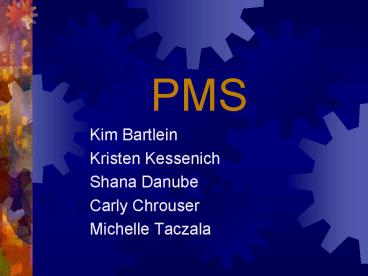PMS PowerPoint PPT Presentation
1 / 15
Title: PMS
1
PMS
- Kim Bartlein
- Kristen Kessenich
- Shana Danube
- Carly Chrouser
- Michelle Taczala
2
PMS aka
- Premenstrual distress
- Congestive dysmenorrhea
- Pelvic congestion syndrome
- Toxemia of menstruation
- Premenstrual syndrome
3
Something to think about
- Do you think that PMS is real or made-up by
society? - Real
- Made-up
4
Something to think about
- Can you name any positive symptoms associated
with PMS? - Creativity
- Heighten senses (hearing, vision, and sight)
- Heightens sexual receptiveness
5
Premenstrual Syndrome
- What is Premenstrual Syndrome (PMS)?
- PMS is the name of a group of symptoms that start
7 to 14 days before your period (menstruation).
6
Symptoms
- Headache
- Fatigue
- Breast tenderness
- Abdominal bloating
- Weight gain from fluid retention
- Tension and anxiety
- Mood swings and irritability or anger
- Joint or muscle pain
- Appetite changes and food cravings
- Crying spells
- Depressed mood
7
Statistics of affected women
- 70 to 90 percent of menstruating women experience
some form of PMS - Those with PMS symptoms are usually in their 20s
or 30s - For 30 to 40 percent of women, the physical pain
and emotional stress from PMS are severe enough
to effect their daily routines - Premenstrual Dysphoric Disorder (PMDD) is a more
severe form of PMS with depressive tendencies
8
Possible Factors
- Chemical changes in the brain (insufficient
amount of serotonin) causing fatigue, food
cravings, and sleep problems - Stress
- Low levels of vitamins and minerals
- Fluid retention caused by eating salty foods and
drinking alcohol and/or caffiene
9
Cyclical changes
- Keep a record of your signs and symptoms on a
calendar or in a diary for at least two menstrual
cycles - Note the day you first notice symptoms appear and
disappear - Mark the day your period started
10
Commonly prescribed medications
- Nonsteroidal anti-inflammatory drugs (NSAIDs)
such as Advil, Motrin, or Aleve - Oral contraceptives to stop ovulation
- Antidepressants such as SSRIs, Prozac, Paxil, and
Zoloft - Medroxyprogesterone acetate to temporarily stop
ovulation
11
Personal remedies
- Modify your diet
- Eat smaller portions more frequently
- Monitor salt intake
- Choose foods high in complex carbohydrates
(fruits, vegetables, whole grains) - Choose foods rich in calcium
- Take multivitamin supplements
- Avoid high intake of caffeine and alcohol
12
Personal remedies cont
- Incorporate aerobic activity for at least 30 to
60 minutes most days of the week - Reduce stress level
- Get plenty of sleep
- Identify the triggers and timing of your symptoms
to find strategies to lessen them
13
In conclusion
- Although no one knows for sure, research has
shown that PMS may be linked to hormonal changes - If you have symptoms that persist even after
trying home remedies, you may want to consult
your personal physician
14
Sources and resources
- www.nlm.nih.gov
- Biology of Women textbook
- Counseling and Health Center located in room
SS1400 or by phone 465-2380
15
Questions?

